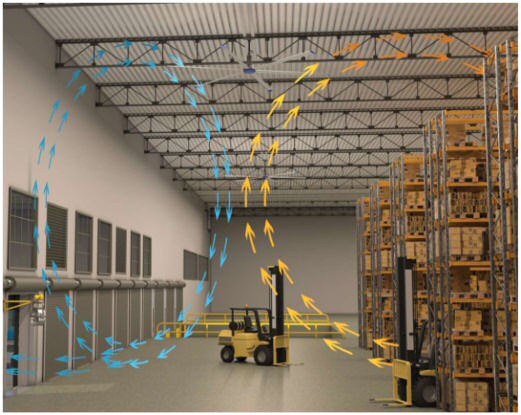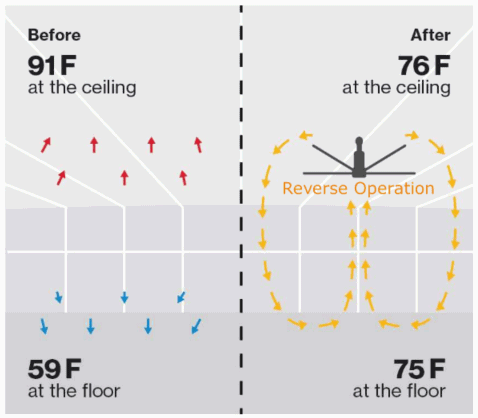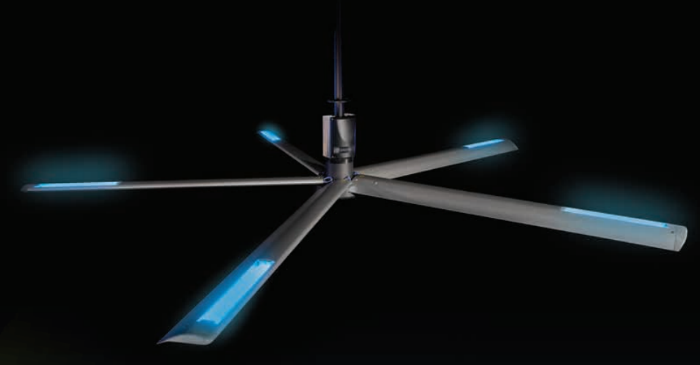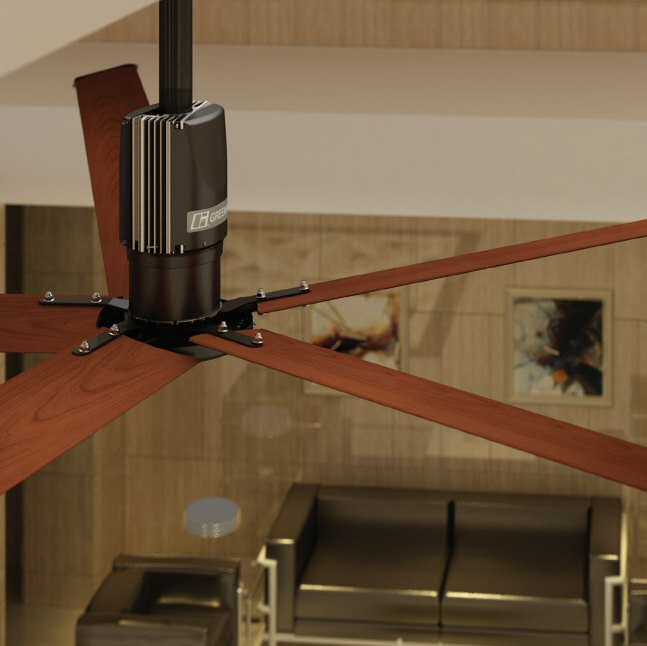To say that High Volume Low Speed (HVLS) fans will solve ALL your problems is, obviously, an exaggeration. However, HVLS fans are one of the most versatile air movement products in the HVAC industry, solving a multitude of issues encountered by the design engineer and building owner. These fans are utilized in Industrial, Commercial, Educational, Government, Retail and Agricultural applications.
What are HVLS fans?
Very simply put, HVLS fans are large diameter ceiling fans (anywhere from 8’ to 24’) designed to move high volumes of air (up to well over 240,000 cfm) at low rotational speeds (60 to 200 rpm).

Figure 1: HVLS fan installed in a warehouse. Image taken from Greenheck presentation, Nov. 2022 (Click image to see full-size version.)
HVLS fans are typically installed in large, open spaces with high ceilings to improve occupant comfort and productivity, reduce HVAC system costs and increase efficiency, support occupant and worker safety, and enhance architectural aesthetics.
Occupant Thermal Comfort and Productivity
The first benefit of HVLS fans that we will look at is occupant thermal comfort and productivity. Experience and common sense tell us that humans are more productive when they are in a comfortable environment. Studies back this up and have determined that peak productivity occurs between 70-72oF. As a rule of thumb, for every 1o F of occupant discomfort there is a corresponding drop in productivity of 1%.
HVLS fans improve occupant comfort in two ways. In summer, they elevate air speed to provide a perceived cooling effect through evaporative cooling. The downward movement of air from the HVLS fan flows across the skin, evaporating any moisture present and carrying away body heat. So, even though the fan does not change the actual air temperature of the space, the occupant can feel up to 15oF cooler. In winter, large spaces with high ceilings can easily stratify with warm air rising to the ceiling and colder air remaining at the floor. HVLS fans evenly distribute and de-stratify the air to provide a uniform temperature throughout.

Figure 2: Destratification with an HVLS fan. Image taken from Greenheck presentation, Nov. 2022 (Click image to see full-size version.)
Reduced HVAC System Cost and Increased Efficiency
The second benefit of HVLS fans is that they reduce HVAC system costs and increase efficiency. Because the occupants experience the cooling effect of the HVLS fan, space temperature setpoints can be increased in summer, potentially reducing the required tonnage of the cooling equipment. In winter, ASHRAE Standard 62.1 (Ventilation and Acceptable Indoor Air Quality) requires increased ventilation for spaces with ceiling supply and return due to stratification. HVLS fans de-stratify the air, eliminating the need for increased ventilation and reducing the size of the make-up air units required for the space.
According to a 2015 study (Building and Environment), HVLS fans save 30% of both heating and cooling costs through de-stratification and the cooling effect. As a rule of thumb, there is an approximate 5% energy cost savings per 1o F setpoint change.
These savings are only possible if you can accurately determine your airflow, airspeed, and effective coverage area. The Air Movement and Control Association (AMCA) provides third-party certification for HVLS fans to ensure that the fan performance published by the manufacturer is accurate. If a fan meets the AMCA test standard, it will bear an AMCA seal. This seal is the only way for you to be able to select the right fan with confidence so be sure to look for it from your HVLS supplier.
Improved Health and Safety
In addition to providing occupant comfort and reducing costs, HVLS fans improve occupant health and safety. In warehouses that store chemicals or factories where processes produce irritant fumes, continuous airflow improves the Indoor Air Quality (IAQ) through the elimination of stagnant and/or dilution of contaminated air.
Airborne pathogens have been a hot topic in light of the recent COVID-19 pandemic. Building owners and employers have been searching for effective means of reducing these pathogens to make their workplaces safe for employees, allowing employers to keep the doors open and employees working. UV-C light is shown to be an effective means of inactivating viruses, making them unable to replicate. Applying UV-C technology to HVLS fan blades provides an efficient means of circulating vast amounts of air through the “kill zone” of UV-C, rendering the space “clean” of airborne pathogens.

Figure 3: HVLS fan with UV-C lights. Photo courtesy of Greenheck Fan Corporation (Click image to see full-size version.)
Continuous airflow also provides an air curtain effect that deters pests such as insects and the rotation and reflectivity of the blades prevents birds and rodents from nesting in the ceiling trusses.
High air temperature differentials can increase the chance of the formation of condensation on floors and surfaces. Wet surfaces are a leading cause of slip-and-falls in the workplace leading to workers compensation claims that can cost corporations millions of dollars. According to data provided by the National Floor Safety Institute (NFSI):
- 85% of worker’s compensation claims are attributed to employees slipping on slick floors (Industrial Safety & Occupational Health Markets 5th edition)
- 22% of slip/fall incidents resulted in more than 31 days away from work (US Bureau of Labor Statistics (2002).
- Compensation & medical costs associated with employee slip/fall accidents is approximately $70 billion annually (National Safety Council Injury Facts 2003 edition).
When selected correctly, HVLS fans minimize air temperature differentials and increase evaporation rates to help keep floors and surfaces free of condensation. And, since they are mounted in the ceiling, they do not create a trip hazard like traditional, floor mounted air circulators.
Architectural Aesthetics
In addition to all the benefits that HVLS provides the HVAC system, they also can be an aesthetically appealing addition to any environment. A variety of blade configurations and finishes can complement the architectural design of any building. Custom color options coordinate with corporate colors and logos can be utilized to create a high impact statement.

Figure 4: HVLS fan with wood-grain blade finish. Photo courtesy of Greenheck Fan Corporation (Click image to see full-size version.)
From system efficiency to occupant safety to architectural aesthetics, HVLS fans provide a multitude of solutions to common issues facing the design engineer and building owner. Brucker represents Greenheck’s AMPLIFY HVLS line, offering models with airflow capacities up to 243,000 cfm and 24 feet in diameter, along with UV-C lighting and custom colors to fit any application. Contact your local Brucker representative to learn more about this line.
- Seppanen, O., Fisk, W., Lei, Q. (2006). Room Temperature and productivity in office work. Lawrence Berkeley National Laboratory. Retrieved from https://escholarship.org/uc/item/9bw3n707
- Tyler Hoyt, Edward Arens, Hui Zhang. Extending air temperature setpoints: Simulated energy savings and design considerations for new and retrofit buildings. Building and Environment, Volume 88, 2015, Pages 89-96, ISSN 0360-1323, https://doi.org/10.1016/j.buildenv.2014.09.010
- National Floor Safety Institute. (n.d.). Slip & fall quick facts. NFSI. https://nfsi.org/nfsi-research/quick-facts/
- Greenheck Fan Corporation. (2022, October). Amplify HVLS Fan Sizing & Specification. Schofield, WI.

Recent Comments